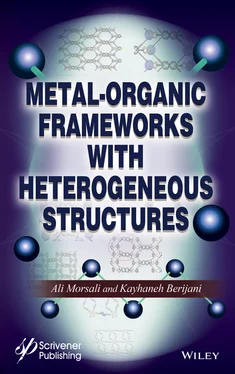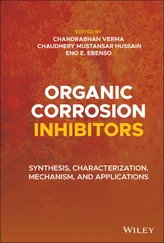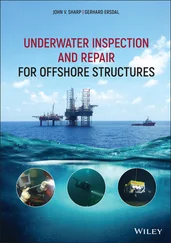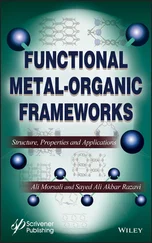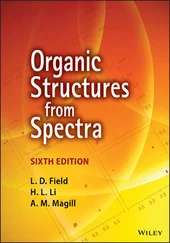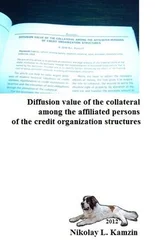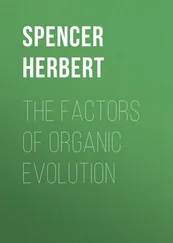8 Figure 2.5Defective linker concept for defect-engineered MOFs.
9 Figure 3.1 A photocatalyst MOF with three different ditopic linkers.
10 Figure 3.2 Structural analyses of a MOF-based photocatalyst with three different ditopic linkers. (a) Percent of BPDC-(HN2)2 incorporation in ReMOF-NH2 (X%). (b) PXRD patterns: Re-MOF, Re-MOF-NH2 (33%), Re-MOF-NH2 (80%) and Re-MOF simulated pattern. (c) SEM images: Re-MOF-NH2 (33%) and Re-MOF-NH2 (80%). (d) N2 adsorption isotherms: Re-MOF, Re-MOF-NH2 (33%) and Re-MOF-NH2 (80%). (e) IR spectra: Re-MOF, Re-MOF-NH2 (33%) and Re-MOF-NH2 (80%).
11 Figure 3.3 (a) Copper-phosphonate CBU polyhedral. Octahedral Cu1 and square pyramidal Cu2: dark blue and light blue, respectively. PO3C tetrahedral: green. (b) The original structure of the considered isoreticular MOF.
12 Figure 3.4 Schematic representations of the happened processes in MOF with increased porosity. (a and b) Organic linker installation and linker labilization, respectively. (c) The produced hierarchically porous MOF through linker labilization (top). UV-vis analysis of linker exchange process. (a) Concentration of AZDC in supernatant as a function of incubation time in CBAB solutions with different concentrations. (b) Relationship between CBAB exchanged/CBAB added, exchange ratio, and CBAB molarity. (c) PCN-160 crystals images with various exchange ratios.
13 Figure 3.5 Schematic representations of construction mechanism. (a) Formed micropores, (b and c) small and large mesopores, and (d) pores size distribution of the considered MOF (PCN-160-34%) in the presence of acid in different amounts. (Top) (a) Representation of one kind of MOF in the presence of enzyme. (b) relative activity of the considered MOFs in the oxidative reaction of ABTS (2,2′-azino-bis(3-ethylbenzothiazoline-6-sulphonic acid)) and o-PDA (o-phenylenediamine).
14 Figure 3.6 One kind of mixed-valence RuII/III MOF with mixed-linker.
15 Figure 3.7 Olefin hydrogenation mechanism.
16 Figure 3.8 Zeolite-like MOFs based on mixed linkers.
17 Figure 3.9 A mixed-ligand MOF with two ligands BTC (benzene-1,3,5-tricarboxylate) and BTRE (1,2-bis(1,2,4-triazol-4-yl)-ethane).
18 Figure 3.10 Stepwise preparation of {[Cu4(CDC)4(4,4′-bipy)(H2O)2]3}n·xS. Copper: aqua; oxygen: red; nitrogen: blue; carbon; black. Hydrogen atoms have not been shown (top). Synthesis of the isostructural porphyrinic MOFs and obtained crystals photographs (bottom).
19 Figure 3.11 ADES-1: (a) coordination environment around Zn(II); (b) and (c) [Zn2(COO)2] SBU in 1D metal-carboxylate chain and double lined 2D network, respectively; (d) ABAB manner interlayer with lattice H2O.
20 Figure 3.12 ADES-2: (a) coordination environment around Cd(II); (b) and (c) [Cd2(COO)2] SBU in 1D metal-carboxylate chain and double lined 2D network, respectively; (d) Offset stacked 2D layers with the lattice H2O and π···π stacked L.
21 Figure 3.13 Direct synthesis mixed-ligands MOF film, RuB-RuTB-UiO-67/TiO2/FTO through solvothermal method.
22 Figure 4.1 Some of the tritopic linkers.
23 Figure 4.2 The symmetry in organic linker. Tetratopic linkers with (a) symmetry C2h and (b) symmetry Cs.
24 Figure 4.3 Some of the tetratopic linkers.
25 Figure 4.4 A mixed-ligand MOF with tetratopic organic linkers.
26 Figure 4.5 Some of the multi-topic linkers.
27 Figure 4.6 A kind of MOF with multi-hetero topic organic linker.
28 Figure 4.7 (a) Cu(II) Coordination environment. Symmetric nodes: (i) y, 1 - x, 1 - z; (ii) y, x, 1 – z; (iii) 1 - y, x, 1 – z; (iv) 1 – x, y, z; (v) x, 1 – y, z; (vi) -x, 1 – y, z; (vii) -x, y, z; (viii) y, x, -z; (ix) -y, x, -z; (x) y, -x, -z. (b) Distorted truncated octahedron cage: (trinuclear + tetranuclear) SBUs. (c) Illustration of three dimensional porous framework in the considered MOF.
29 Figure 5.1 Two synthesis strategies to create MM′-MOFs.
30 Figure 5.2 Two synthetic methods to create 2D gird MM′-MOFs.
31 Figure 5.3 The incorporated BPDC, RuDCBPY, and PtDCBPY into Zr-MOF (UiO-67) through the solvothermal method. Red balls: SBUs. Gray rod: BPDC. Purple rod: RuDCBPY. Yellow rod: PtDCBPY. This figure is copied with the permission of the mentioned reference.
32 Figure 5.4 (a) Powder x-ray diffraction patterns, (b) IR spectra, and (c) TGA analysis of UIO-67black, Pt@ UIO-67red, and Ru-Pt@UIO-67blue. (d) Connolly-surface-filling model demonstrates mother MOFs of UIO-67 (pore size: 8–10 Å).
33 Figure 5.5 (a–c) SEM and (d–j) HAADF-STEM images of the considered samples (top). UV-vis of bpdc, RuDCBPY (aqueous solution), and PtDCBPY (MeOH). (a, b) Diffuse reflectance of the considered samples (middle). (c) Powdery samples photographs under natural light (bottom).
34 Figure 5.6 The formation of coordination polymers from the corresponding metals [4 to 8]/[Cu(2,2′-bpy)]2+[9]/[10] and metalloligand [LCu].
35 Figure 5.7 The epitaxial growth of the trimetallic and bimetallic hetero-(Ln)-MOFs from the crystal seed with one type of metal.
36 Figure 5.8 Transmetalation in porph@MOM-10 (a) and MSO-MOF (b). [Panel (b): metalation after demetalation of MOF].
37 Figure 5.9 (a) 3D structure of [Gd3Cu12I12(IN)9(DMF)4]n. nDMF. (structure I) (b) [Cu12I12] cluster. (c) Tri-nuclear [Gd3(IN)9(DMF)4] units (top). (a) 3D structure of [Gd4Cu4I3(CO3)2(IN)9(HIN)0.5(DMF) (H2O)]n.nDMF.nH2O. (structure I) (b) [Cu3I2] cluster. (c) Gd4(CO3)2 chains (bottom).
38 Figure 5.10 The solid-state luminescent properties of MOFs with diverse SBUs.
39 Figure 5.11 (a and b) MOF 1 structure showing Co3 SBU supported by Co1 and Co2 viewing from two directions. (c) Three-dimensional network viewing along the [010] direction.
40 Figure 6.1 (a) Two types of chiral tetrahedral SBUs. (b) A perspective view of microporous framework: zinc, azury; carbon, gray; oxygen, red. Water molecules of lattice are eliminate for clarity (left). Adsorption isotherm of methane at 298 K, and H2 adsorption desorption isotherms (77 K, inset) activated at 100°C (blue) and 175°C (red) (right and top). Polarization (P) versus applied field (E) hysteresis loops from a single crystal sample (right and bottom).
41 Figure 6.2 (a) Schematic representation of a chiral MOF catalyst by PSM. (b) The chemical structures of the used chiral ligands based on tetracarboxylic acids.
42 Figure 6.3 Crystal structure of chiral MOF-1a. (a)Paddle-wheels clusters based on Cu and their connectivity with chiral L1a ligands. (b) L1a: blue distorted tetrahedro; Cu-paddle-wheel cluster: red square. (c) Connectivity of L1a organic ligands and Cu-paddle-wheel node. (d) Stick model. (e) Representation of a simplified connectivity (top). (a–h) Space-filling models of CMOF-1b to -4b with pores size (bottom).
43 Figure 6.4 (a and b) Views of connectivity around metallic centers in structure 2, highlighting D,L-enantiomeric Cd2+ ions. (c) The one-dimensional zigzag coordination chain structure in 2. Cyan: Cd(1); pink: Cd(2) atom; red: oxygen atom; blue: nitrogen atom; gray: carbon atom; yellow: hydrogen atom. α-methyl groups of D-HCam organic ligands: green-colored balls (similar to Zn-analogous 3).
44 Figure 6.5 Total synthesis of CMOF with chiral axial ligand.
45 Figure 6.6 Different cavity sizes in CMOFs.
46 Figure 6.7 Stick/polyhedra models of CMOF-1-5 with the presence of interpenetration along with connectivity of ligands and SBUs.
47 Figure 7.1 An example of the chiral templating effect origin.
48 Figure 7.2 Synthesis method of Ni-PYI1, guest exchange, and the considered asymmetric catalysis.
49 Figure 7.3 Examples of the post-chiral modification of achiral MOF-NH2 as capillary columns for chiral GC.
50 Figure 7.4 (a–d) GC chromatograms based on chiral MOF-based columns to separate racemates under different conditions. (a) MIL-101-S-2-Ppa coated column A: 2-methyl-2,4-pentanediol (160°C, 2 ml min−1 N2); 1,2-pentanediol (160°C, 2 ml min−1 N2); citronellal (165°C, 2 ml min−1 N2). (b) MIL-101-R-Epo coated column B: 2-butanol (150°C, 2 ml min−1 N2); 1-heptyn-3-ol (200°C, 2 ml min−1 N2); citronellal (180°C, 2 ml min−1 N2). (c) MIL-101-(+)-Ac-L-Ta coated column C: 1-amino-2-propanol (210°C, 2 ml min−1 N2); 2-amino-1-butanol (210°C, 2 ml min−1 N2); 1,2-pentanediol (210°C, 3 ml min−1 N2). (d) MIL-101-L-Pro coated column D: Mandelonitrile (200°C, 1.8 ml min−1 N2); 1-phenylethylamine (180°C, 2 ml min−1N2); methyl-2-chloropropionate (180°C, 2 ml min−1 N2).
Читать дальше
